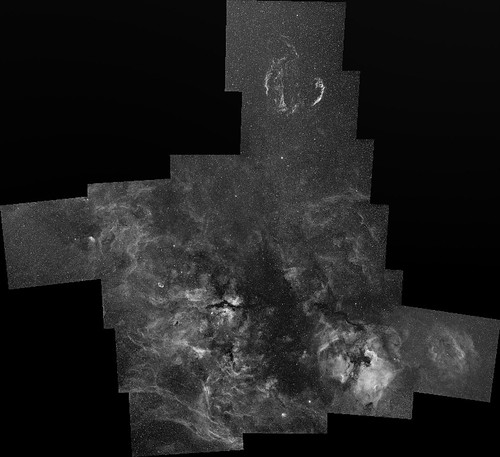Create a free profile to get unlimited access to exclusive videos, sweepstakes, and more!
Incredible panorama of the summer sky

The fantastic astrophotographer André vd Hoeven sent me a note recently saying he had been playing with a new lens he bought, and wanted to attach it directly to a CCD camera - a digital detector like a store-bought camera, but designed specifically for astrophotography. Usually those are mounted on the back of a telescope, but with a camera lens on it the assembly takes very wide angle shots of the sky.
How wide? Well, he made a 4x4 mosaic of the entire summer constellation of Cygnus the Swan, and it's breathtaking:
[Click to enanatidaenate, or get the massive 6200 x 5200 pixel version.]
Yegads! He used a filter on the camera that lets through the light of warm hydrogen, so it picks up the gas floating between the stars. So besides the stars in the picture you also see huge amounts of interstellar gas from exploding stars, stars being born, stars lighting up the material around them... it's amazing.
He helpfully created an annotated version that explains what you're seeing:
[Again, click to embiggen, or get the huge one.]
Mind you, each of the 16 tiles that make up this panorama is itself made of three 300 second exposures - 15 minutes total each. So this incredible image only took about four hours to take! Perhaps just as incredibly, he told me he took these images just 15 kilometers from Rotterdam, a heavily-light polluted city in the Netherlands. The filter he used cuts out a lot of the stray light from the city, making it easier to see the faint stuff out there in space.
It is simply stunning to me that pictures like this can be taken under these circumstances. Fifty years ago astronomers would have cheerfully killed their best friend for this capability, and now you can do it yourself. I remember when I first used a digital detector - I was in grad school, and the chip was something like 300 x 500 pixels in size. State of the art back then (I'm old, see). We started playing with it, and within minutes a serious wave of awe washed over me. This technology will revolutionize astronomy, I thought to myself.
It did. It was as big a leap in the tech for astronomy as the invention of the camera itself. It allowed us to take deep images from the ground, and to launch sophisticated and extremely sensitive cameras into space aboard telescopes. That in turn has led to some of the most basic discoveries in astronomy over the past few decades.
And it's something you can now use literally from the comfort of home.
Image credit: André vd Hoeven, used with permission.
Related Posts:
- The lovely faces and dark hearts of two galaxies
- Jaw-dropping Moon mosaic (seriously, click this!)
- A spiral that can beat you with two arms tied behind its back
















